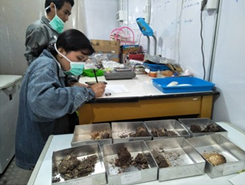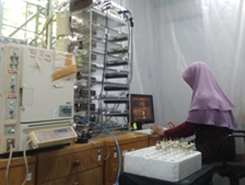Soil and greenhouse gas laboratory – Bogor
It is equipped with facilities to analyze soil and vegetation properties and greenhouse gas concentrations and fluxes.
Analysis
The analyses that can be run in the soil laboratory are:
- Sample preparation – Drying, sieving, crushing and mixing soil/biomass sample
- pH measurement
- Sample extraction for specific analysis that cannot be done in CIFOR laboratory (i.e. for ammonium-nitrate analysis)
- Gas analysis – measuring concentration of CO2, N2O and CH4 (the analysis should be done by our technician.
Analytical equipment
- Gas chromatograph:
instrument to measure soil N2O and CH4 gas concentrations (Shimadzu 14A equipped with ECD Detector, FID Detector and autosampler) - CO2 analyzer:
instrument to measure soil respiration in-situ (IRGA-LICOR 840/840A, EGM-4 PP System) - Near Infrared (NIR) Spectrograph:
This is a portable instrument that is designed for obtaining in-situ and ex-situ high spectral resolution reflectance measurements in the visible and shortwave infrared wavelengths (350 nm to 2500 nm) for measuring carbon content from soil samples (ASD fieldSpec-4)
We also have the supporting equipment to prepare and store samples:
- Mixer mill:
Instrument for crushing and mixing sample of soil and vegetation (Retsch MM 200) - Oven for drying soil and vegetation samples (Binder FED 720 and Memmert UNB500)
- Field sampling and survey equipment (GPS, auger, barometer, soil thermometer, etc.)
Tree ring laboratory – Bogor
The laboratory is equipped with instruments to analyze and photograph tree rings (tree growth zones). The microscope can also be used to study soil macrofauna.
Equipment
- Tree increment borers: equipment to collect tree stem cores for further analysis.
- Bernardo wood sanding machine: equipment to polish stem discs.
- Leica Microsystem: microscope, camera and computer programme to analyze and capture images of growth zones / tree rings and macro-fauna.
- Lintab 6: equipment to count and measure the width of tree rings (Figure 11)
- Epson Scanner: equipment to scan images of tree stem cross section /rings.
Analysis
Tree ring laboratory covers analysis of tree rings/growth zones and macrofauna including:
- Tree rings number
- Tree ring width
- Tree growth zone types
- Tree growth zone distinctiveness
- Soil macrofauna identification until ordo level






















